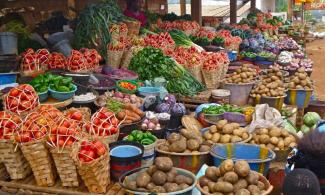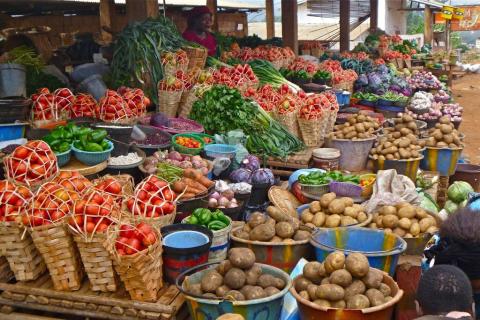
The country’s food crisis is a result of insecurity from Boko Haram terrorists, bandits and killer herders that have forced farmers to abandon their farmlands.
Nigeria is facing a critical hunger level as it ranks 98 out of 107 countries in the 2020 Global Hunger Index.
The country also has the proportion of undernourished in the population rising from 7.6 per cent in 2012 to 12.6 per cent in 2020.

According to a consulting firm focused on Africa geopolitical research and strategic communications, SBM Intel’s report, the country’s food crisis is a result of insecurity from Boko Haram terrorists, bandits and killer herders that have forced farmers to abandon their farmlands.
Other factors, however, are the lack of proper storage facilities, volatile oil prices, climate change, rising cost of energy and logistics, stifling government policies, natural disasters, the Coronavirus pandemic, and currency devaluation.
According to the Nigerian Bureau of Statistics (NBS) report as published by SBM, food inflation has seen a 48.94% rise (from 15.04% to 22.95%).
SBM gathered reports from major food markets across the country and noted how people lamented devastating rising prices of food which have altered their normal daily living.
The prices of most staple food items in a typical Nigerian home, including rice, beans, egg, garri, plantain, yam, beef, palm oil, fish, pepper, tomatoes, onions, bread and groundnut oil, have all surged.
In Lagos, a housewife disclosed to SBM that the food allowance her husband provides could no longer sustain the family. She precisely complained about her failure to buy monthly food items, which now occurs every two weeks or save from the allowances while expenses keep increasing.
A trader in Lagos’s Balogun Market was very specific as to fish, saying that the border closure affected his ability to supplement his fish stock, forcing him to raise prices for the increasingly scarce stock he has.
Most of those interviewed in the low socio-economic echelons admitted they could no longer afford three square meals but had one whole meal daily supplemented with snacks.
Mrs Christiana, a Lagos housewife and entrepreneur disclosed she chose two-square meals daily, as allowances received can no longer afford her family decent three-meal days.
Another respondent who is a wife and mother of two at Sango-Ota, Ogun State, lamented the rapid escalation of prices of commodities in the market at Sango-Ota. She explained how she last went to the market and ended up confused about what exactly to buy since “what N20,000 can but a few months back, today, N40,000 cannot afford the same.”
The price of beans and garri in Sango-Ota rose by a significant 97.9%, which almost doubled within the period under review. Beans rose from N1,457 to N2,883 per four-litre paint rubber and garri saw a price rise from N869 to N1,856 per paint rubber. According to her, the price increases of these two staple foods were the highest in the last one year.
In Port Harcourt, a four-litre paint bucket of garri, which sold for N1,200 at the end of March, rose to N1,500 by June 2021, an increase of 25%. In the same period, a paint bucket of beans, which sold for N1,500, now sells for N1600.
Visits to various markets revealed that in all the markets except in Onitsha, Port Harcourt and Calabar Municipal markets, the cost of making a pot of Jollof rice has skyrocketed. The decline in Anambra, Rivers and Cross River states was as a result of a slight reduction in the cost of beef, onions and tomatoes.